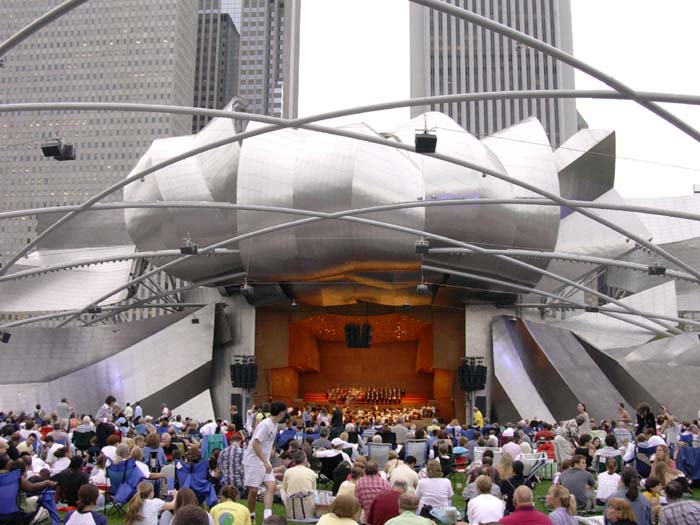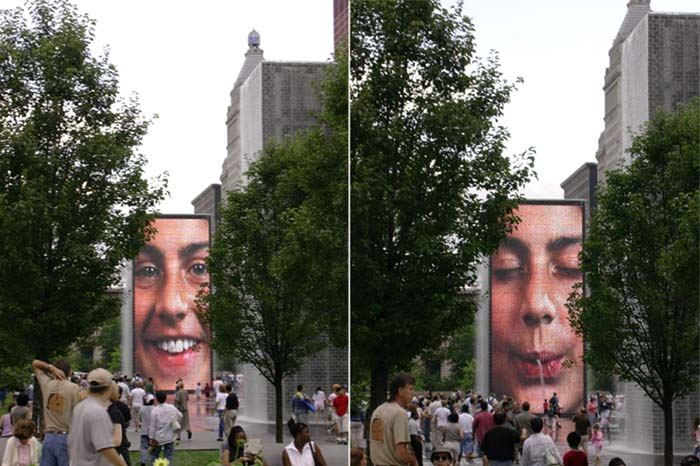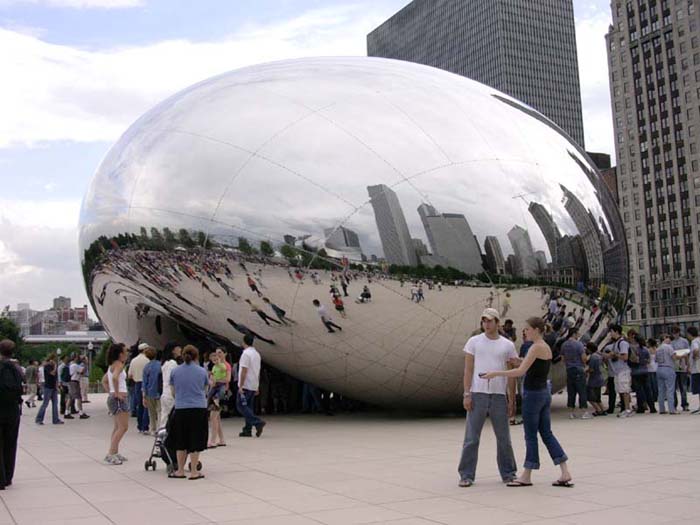A biweekly newsletter with public space news, resources, and opportunities.
A curated dispatch on all things public markets plus the latest announcements from the Market Cities Program.
by Jay Walljasper
"Brilliant" is the word that first comes to mind in seeing Millennium Park, Chicago's much-talked about public space on Michigan Avenue that opened this summer. How often does a city seize the opportunity to create a new park right at its center? Mayor Richard M. Daley and everyone else responsible for the idea of covering a trench of rail lines and parking lots with 24.5 acres of gardens and public attractions deserves hearty praise. Millennium Park offers an oasis of open space in a downtown famous for towering skyscrapers. It is a worthy addition to the celebrated park system mapped out by Daniel Burnham.

But seeing one of the Burnham's creations nearby, Grant Park, highlights the weaknesses of Millennium Park and contemporary park design in general. Grant Park is a place conceived primarily for the pleasure of people. It's walking paths, lawns, monuments, and spectacular Buckingham Fountain exist to stimulate and refresh residents of one of America's most densely-settled cities. Millennium Park, on the other hand, was built to generate buzz. With wow-wow attractions and top-of-the-trend designers like Frank Gehry, it has succeeded at that, and will probably meet its goal of drawing more tourists and conventions to the city. Erecting attention-grabbing landmarks was the main point of Millennium Park's design; providing Chicagoans with a sense of contentment and wonder was a secondary consideration.
Your eyes are dazzled by all the strange and shiny objects, but your soul feels a bit underfed.
Wandering through the park, as I did one beautiful evening in late summer, feels more like attending a splashy Pop Art exhibit than settling into a vital public place. Your eyes are dazzled by all the strange and shiny objects, but your soul feels a bit underfed.
Millennium Park is not actually a park in the strictest sense of the word, but a large plaza on two levels. This should not, however, diminish its potential as a lively urban space. Still, the sheer volume of concrete that went into its construction seems excessive. Pathways and promenades throughout the park are overly wide, and benches way too sparse. With tens of thousands of office workers toiling in nearby towers, ninety-nine percent of them looking for a pleasant spot to eat their lunch, I can't imagine why there aren't more comfortable places to sit.

The park's centerpiece is Frank Gehry's Pritzker Pavilion, a deconstructionist bandshell with a web of criss-crossing metal tubes enclosing a broad lawn stretching out behind the seating. A "Gehry" is de rigueur for any city today that doesn't want to be seen as Podunk, yet this edition of his work made me wonder if the world-renowned Los Angeles designer was paying homage to naturally-occurring architectural forms of the rural Midwest. The jagged metal lines rising high above the stage looked to me remarkably like the remains of metal silos shredded by tornadoes that I saw as a kid growing up in downstate Illinois. The facility is reputed to have excellent acoustics, but no one was playing the night I was there although the pavilion sported a number of visitors dutifully inspecting the place. The name "Gehry," uttered in reverential tones, frequently popped up in snatches of conversations I overheard. As with every other "Gehry" I've run across, the stark and self-conscious sensationalism seemed to overwhelm any communal, human qualities of the place.

Another much-discussed attraction, Spanish conceptual artist Jaume Plensa's Crown Fountain, which is dominated by two enormous video walls projecting faces of everyday Chicagoans, also left me feeling cool. Perhaps it was because I was en route from Boston and had whiled away some of the afternoon at the marvelous Frog Pond wading pool in Boston Common, but the sight of kids splashing in the fountain under the gaze of 50-foot-tall faces seemed a little unnerving. It was a huge distraction from what I really wanted to enjoy: the gleeful faces of kids playing and of adults happy to watch them. Seeing other people is the real reason we humans are so deeply attracted to public spaces. Even in this advanced age of communications technology, exchanging glances with real people satisfies us far more than viewing smiling images on giant video installations.
Faces are also the theme of British sculptor Anish Kapoor's 110-ton "Cloud Gate" -- another of Millennium Park's blockbuster draws. As a smooth, rounded blob of reflective metal in which you can view yourself from many angles, the work has obvious appeal. It's just plain interesting to look at yourself, and even more so to see other people doing the same. It's one of the most compelling public art projects I've ever encountered, but would function better as a public place if there were more benches nearby so you could sit down to watch the fun.

Millennium Park also features a still-evolving prairie garden, a bicycle storage depot (common in Europe but unique in America), an outdoor café (which will be a skating rink in winter), a showpiece bridge crossing the highway in the direction of the lake, a gift shop (where you can buy, of course, Frank Gehry souvenirs), a theater, and classically-inspired walkways and flower displays on the Michigan Avenue side. At the Randolph Street entrance stands a series of Doric-style columns that recreates a monument that stood in the same spot from 1917 to 1953.
All kinds of memories will be made in Millennium Park and it will become part of the emotional fabric of Chicagoans.
It's never easy to critique a park that is just out of its wrapping. The prairie plants here will bloom. The trees will grow. First kisses will happen, and tearful split-ups, too. All kinds of memories will be made in Millennium Park and it will become part of the emotional fabric of Chicagoans.
I was thinking about all this as I toured the park. And then, realizing I was starved after two hours of strolling, I bought a turkey sandwich in the Park Café deli and eventually found a bench to sit upon. Squealing kids ran up and down nearby steps and buildings were silhouetted in the twilight sky. I heard sounds of a flute coming from Michigan Avenue, played by a busker who had set up shop on the sidewalk. Yes, I thought happily, people will make this into a truly great park. It won't be because of the flashy design-for-design's-sake edifices that now attract all the attention. It will be in spite of them. But Millennium Park will flourish because this is a brilliant place to put a park, right in the heart of a city where people naturally want to gather.
The rich text element allows you to create and format headings, paragraphs, blockquotes, images, and video all in one place instead of having to add and format them individually. Just double-click and easily create content.
The rich text element allows you to create and format headings, paragraphs, blockquotes, images, and video all in one place instead of having to add and format them individually. Just double-click and easily create content.
Body Text Body Link
The rich text element allows you to create and format headings, paragraphs, blockquotes, images, and video all in one place instead of having to add and format them individually. Just double-click and easily create content.
Here is some highlighted text from the article.




Headings, paragraphs, blockquotes, figures, images, and figure captions can all be styled after a class is added to the rich text element using the "When inside of" nested selector system.
Headings, paragraphs, blockquotes, figures, images, and figure captions can all be styled after a class is added to the rich text element using the "When inside of" nested selector system.
Headings, paragraphs, blockquotes, figures, images, and figure captions can all be styled after a class is added to the rich text element using the "When inside of" nested selector system.